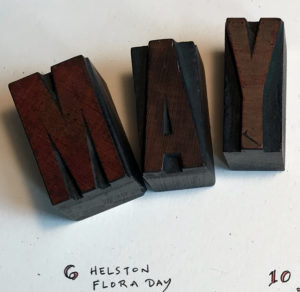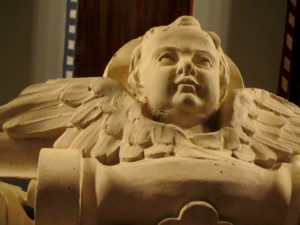Welcome May! Here’s your Convivio Book of Days Calendar for the month. It looks a bit different than usual, but it still prints on standard US Letter size paper. I was in an analog mood when I designed this month’s calendar: I wrote it out with pen and ink. You get my less-than-stellar handwriting and you get a misspelling or two to boot.
And since it is May Day, Margaret next door asked me to share this with you. She says you should read it aloud.
Corinna’s Going a-Maying
by Robert Herrick
Get up, get up for shame, the blooming morn
Upon her wings presents the god unshorn.
See how Aurora throws her fair
Fresh-quilted colours through the air :
Get up, sweet slug-a-bed, and see
The dew bespangling herb and tree.
Each flower has wept and bow’d toward the east
Above an hour since : yet you not dress’d ;
Nay ! not so much as out of bed?
When all the birds have matins said
And sung their thankful hymns, ’tis sin,
Nay, profanation to keep in,
Whereas a thousand virgins on this day
Spring, sooner than the lark, to fetch in May.
Rise and put on your foliage, and be seen
To come forth, like the spring-time, fresh and green,
And sweet as Flora. Take no care
For jewels for your gown or hair :
Fear not ; the leaves will strew
Gems in abundance upon you :
Besides, the childhood of the day has kept,
Against you come, some orient pearls unwept ;
Come and receive them while the light
Hangs on the dew-locks of the night :
And Titan on the eastern hill
Retires himself, or else stands still
Till you come forth. Wash, dress, be brief in praying :
Few beads are best when once we go a-Maying.
Come, my Corinna, come ; and, coming, mark
How each field turns a street, each street a park
Made green and trimm’d with trees : see how
Devotion gives each house a bough
Or branch : each porch, each door ere this
An ark, a tabernacle is,
Made up of white-thorn neatly interwove ;
As if here were those cooler shades of love.
Can such delights be in the street
And open fields and we not see’t ?
Come, we’ll abroad ; and let’s obey
The proclamation made for May :
And sin no more, as we have done, by staying ;
But, my Corinna, come, let’s go a-Maying.
There’s not a budding boy or girl this day
But is got up, and gone to bring in May.
A deal of youth, ere this, is come
Back, and with white-thorn laden home.
Some have despatch’d their cakes and cream
Before that we have left to dream :
And some have wept, and woo’d, and plighted troth,
And chose their priest, ere we can cast off sloth :
Many a green-gown has been given ;
Many a kiss, both odd and even :
Many a glance too has been sent
From out the eye, love’s firmament ;
Many a jest told of the keys betraying
This night, and locks pick’d, yet we’re not a-Maying.
Come, let us go while we are in our prime ;
And take the harmless folly of the time.
We shall grow old apace, and die
Before we know our liberty.
Our life is short, and our days run
As fast away as does the sun ;
And, as a vapour or a drop of rain
Once lost, can ne’er be found again,
So when or you or I are made
A fable, song, or fleeting shade,
All love, all liking, all delight
Lies drowned with us in endless night.
Then while time serves, and we are but decaying,
Come, my Corinna, come, let’s go a-Maying.


